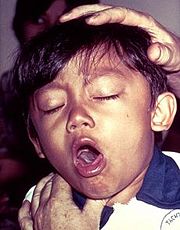Pertussis Toxin-ATP Complex
From Proteopedia
(Difference between revisions)
| Line 9: | Line 9: | ||
==Pertussis Toxin activation== | ==Pertussis Toxin activation== | ||
| - | '''Pertussis Toxin''' by itself is harmless unless activated. From multiple studies, it has became clear that there is a direct interaction between [http://en.wikipedia.org/wiki/Adenosine_triphosphate Adenosine triphosphate] (ATP) and pertussis toxin which leads to activation.<ref name=Hazes>PMID: 8637000</ref><ref name=Kaslow>PMID: 1612292</ref>The direct effect of ATP is to destabilize the interaction between the S1 subunit and the B-oligomer by binding to the B-oligomer.<ref name=Hazes>PMID: 8637000</ref> This interaction relaxes the toxin by facilitating the subsequent reduction of a disulphide bond in the S1 subunit. The main interaction that leads to the destabilization is the favorable hydrogen bonding and electrostatic interaction between the triphosphate moiety and five positively charged amino acids:<scene name='Pertussis_Toxin-ATP_Complex/5_amino_acid_interaction/4'>Arg S2-150, Arg S3-150, Arg S3-151, Arg S4b-69, and Lys S2-151</scene>. In contrast, the negatively charged carboxyl terminus of subunit S1 interacts unfavorably with the negative charges of the triphosphate moiety, causing a displacement of the C-terminal of <scene name='Pertussis_Toxin-ATP_Complex/Real_repulsion/3'>Phe 235:A</scene> therefore, the repulsion between the triphosphate moiety and the C terminus of subunit S1 forms the mechanism by which the interaction between S1 and the B-Oligomer is destabilized.<ref name=Hazes>PMID: 8637000</ref>The details of the [http://proteopedia.org/wiki/images/9/94/PT_ATP_complex.png protein-ATP interactions] can also be seen here.<ref name=Hazes>PMID: 8637000</ref> | + | '''Pertussis Toxin''' by itself is harmless unless activated. From multiple studies, it has became clear that there is a direct interaction between [http://en.wikipedia.org/wiki/Adenosine_triphosphate Adenosine triphosphate] (ATP) and pertussis toxin which leads to activation.<ref name=Hazes>PMID: 8637000</ref><ref name=Kaslow>PMID: 1612292</ref>The direct effect of ATP is to destabilize the interaction between the S1 subunit and the B-oligomer by binding to the B-oligomer.<ref name=Hazes>PMID: 8637000</ref> This interaction relaxes the toxin by facilitating the subsequent reduction of a disulphide bond in the S1 subunit. |
| + | |||
| + | The main interaction that leads to the destabilization is the favorable hydrogen bonding and electrostatic interaction between the triphosphate moiety and five positively charged amino acids:<scene name='Pertussis_Toxin-ATP_Complex/5_amino_acid_interaction/4'>Arg S2-150, Arg S3-150, Arg S3-151, Arg S4b-69, and Lys S2-151</scene>. In contrast, the negatively charged carboxyl terminus of subunit S1 interacts unfavorably with the negative charges of the triphosphate moiety, causing a displacement of the C-terminal of <scene name='Pertussis_Toxin-ATP_Complex/Real_repulsion/3'>Phe 235:A</scene> therefore, the repulsion between the triphosphate moiety and the C terminus of subunit S1 forms the mechanism by which the interaction between S1 and the B-Oligomer is destabilized.<ref name=Hazes>PMID: 8637000</ref>The details of the [http://proteopedia.org/wiki/images/9/94/PT_ATP_complex.png protein-ATP interactions] can also be seen here.<ref name=Hazes>PMID: 8637000</ref> | ||
==Mechanism of pathogenesis== | ==Mechanism of pathogenesis== | ||
Revision as of 22:22, 15 November 2011
| |||||||||||
References
- ↑ 1.00 1.01 1.02 1.03 1.04 1.05 1.06 1.07 1.08 1.09 1.10 1.11 1.12 Hazes B, Boodhoo A, Cockle SA, Read RJ. Crystal structure of the pertussis toxin-ATP complex: a molecular sensor. J Mol Biol. 1996 May 17;258(4):661-71. PMID:8637000 doi:10.1006/jmbi.1996.0277
- ↑ 2.0 2.1 Carbonetti NH, Artamonova GV, Mays RM, Worthington ZE. Pertussis toxin plays an early role in respiratory tract colonization by Bordetella pertussis. Infect Immun. 2003 Nov;71(11):6358-66. PMID:14573656
- ↑ Cornia PB, Hersh AL, Lipsky BA, Newman TB, Gonzales R. Does this coughing adolescent or adult patient have pertussis? JAMA. 2010 Aug 25;304(8):890-6. PMID:20736473 doi:10.1001/jama.2010.1181
- ↑ Bettiol S, Thompson MJ, Roberts NW, Perera R, Heneghan CJ, Harnden A. Symptomatic treatment of the cough in whooping cough. Cochrane Database Syst Rev. 2010 Jan 20;(1):CD003257. PMID:20091541 doi:10.1002/14651858.CD003257.pub3
- ↑ Weiss AA, Johnson FD, Burns DL. Molecular characterization of an operon required for pertussis toxin secretion. Proc Natl Acad Sci U S A. 1993 Apr 1;90(7):2970-4. PMID:8464913
- ↑ 6.0 6.1 Kaslow HR, Burns DL. Pertussis toxin and target eukaryotic cells: binding, entry, and activation. FASEB J. 1992 Jun;6(9):2684-90. PMID:1612292
- ↑ Kenneth Todar, PhD. (2008). http://www.textbookofbacteriology.net/pertussis.html
- ↑ Plaut RD, Carbonetti NH. Retrograde transport of pertussis toxin in the mammalian cell. Cell Microbiol. 2008 May;10(5):1130-9. Epub 2007 Dec 31. PMID:18201245 doi:10.1111/j.1462-5822.2007.01115.x
- ↑ Kenneth Todar, PhD. (2008). http://www.textbookofbacteriology.net/pertussis.html
- ↑ Kenneth Todar, PhD. (2008). http://www.textbookofbacteriology.net/pertussis.html
- ↑ Centers for Disease Control and Prevention. http://www.cdc.gov/pertussis/clinical/treatment.html
- ↑ Altunaiji S, Kukuruzovic R, Curtis N, Massie J. Antibiotics for whooping cough (pertussis). Cochrane Database Syst Rev. 2007 Jul 18;(3):CD004404. PMID:17636756 doi:10.1002/14651858.CD004404.pub3
- ↑ Kenneth Todar, PhD. (2008). http://www.textbookofbacteriology.net/pertussis.html

